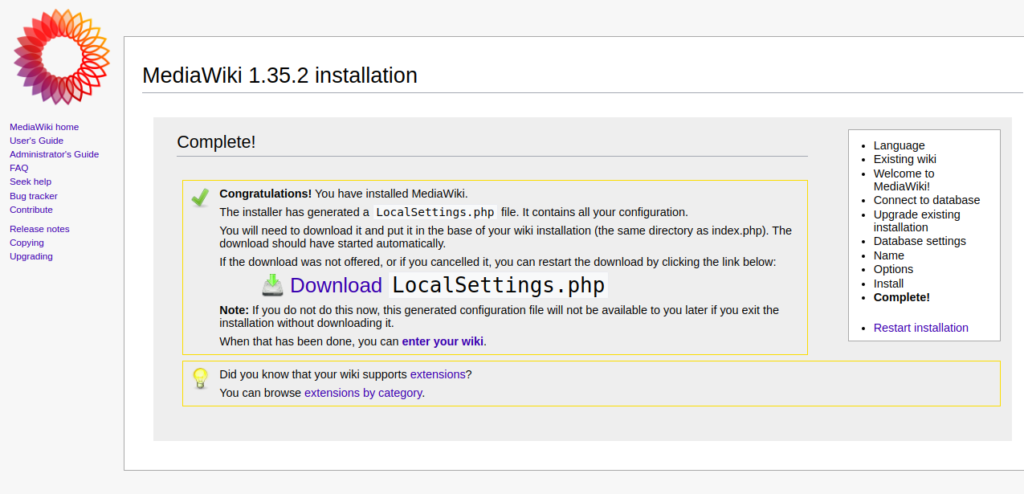

- Mediawiki configure manual#
- Mediawiki configure archive#
- Mediawiki configure software#
- Mediawiki configure password#
My understanding of Container Station is it’s meant to be noob friendly but it actually feels the complete opposite. I did try configuring MediaWiki on my previous QNAP NAS but because it was being installed along side everything else I had, the PHP versions were conflicting with something else and it was just a mess. It also never had any virtualization ability or QNAP Container Station so there was quite a lot of things I wasn’t able to do that I would have liked. Automated processes, packages, bundles, and services all come with their own idiosyncrasies.I recently bought a new QNAP to replace my old one as it 8 years old and was starting to struggle with basic tasks.
Mediawiki configure manual#
Manual installation is often the preferred method because it gives the user more control and insight into how their wiki is installed, making troubleshooting and maintenance easier. Appendices Alternatives to manual installation Subscribe to the MediaWiki release announcements mailing list. Once installed, make sure you stay up to date with releases, and keep your server secure!
Mediawiki configure password#
The following commands create a database named my_wiki, a user named wikiuser, and set permissions for the user on that database.ĬREATE USER wikiuser WITH NOCREATEDB NOCREATEROLE NOSUPERUSER ENCRYPTED PASSWORD 'database_password' CREATE DATABASE my_wiki WITH OWNER wikiuser īeware of the list of known issues when running MediaWiki with PostgreSQL. Alternatively, contact your hosting provider to have them create an account for you. See the corresponding documentation of your hosting provider. Use ssh to log into your host and type the commands below into a MySQL prompt.
Mediawiki configure software#

If you already have a database server and know the password for the "root" (admin) user, skip to the #Run the installation script section below. MediaWiki's installation script will ask you for a database name and database username, so MediaWiki can store the content of the wiki. If your web server is running as for example, renaming to /w/ directory would mean you would access your wiki at Do not use /wiki/ if you want to set it up as a Short URL after running the installation script. Rename the uploaded folder to whatever you would like to have in the URL.

In Red Hat and Fedora, the file is /etc/httpd/conf/nf. In Debian and Ubuntu, the file for Apache server settings and directories is /etc/apache2/nf. The exact location of the Apache server settings and directories file nf depends on your operating system. If you use the Apache HTTPD web server, the correct directory is specified in your nf file in the DocumentRoot directive.īy default, this is /var/www/ or /htdocs. If your upload tool has a "change file names to lowercase" option, then you must disable this. by using software already provided by your hosting service, such as the cPanel File Manager.by using an FTP client such as FileZilla (Windows, OSX and Linux) or Cyberduck (Windows and OSX).directly copying the unzipped folder or.Upload the files to your web server's web directory either by: If you have not already uploaded the files to your web server (or copied, if your web server software runs locally on your localhost), do so now. On Linux systems, the command would be using chown as the following: chown -R More info: Manual:Security#File_permissions
Mediawiki configure archive#
If you uncompress the archive file while being the root/admin user, you may want to change file ownership afterwards, depending on your setup.


 0 kommentar(er)
0 kommentar(er)
